Year patterns of climate impact models' performance: Long-term simulation of rainfed spring wheat production using five crop models under various climate patterns
IF 6.5
1区 农林科学
Q1 AGRONOMY
引用次数: 0
Abstract
Crop models serve as powerful tools for investigating the interaction of crop traits, environmental fluctuations, and management practices. However, the calibration of these models relies heavily on experiments conducted under specific conditions or within particular years. The adaptability and efficacy of these calibrated models across different year patterns of climate remain uncertain. Our analysis aimed to evaluate the utility of these models across diverse climatic patterns and explore potential factors contributing to their performance variations. In this study, experiments were conducted in a semi-arid region characterized by significant climate variability, and data collection was undertaken to assess the performance of five distinct crop models (APSIM, AquaCrop, DSSAT, SSM-iCrop, WOFOST). The field experimental results indicated that year patterns of climate for rainfed spring wheat was jointly determined by soil water at planting and atmospheric moisture conditions during the growing season. After calibration, all five crop models effectively captured the growth, development, and yield formation of spring wheat. Notably, both simple and complex models exhibited similar performance in simulating the spring wheat growth and yield formation. However, the simulation results for spring wheat yield varied among the different year patterns of climate. Particularly in drier climate regimes, most models tended to overestimate spring wheat yields, with calculated relative root mean square errors exceeding 30 %. These findings suggested that calibrated models might not universally represent crop growth, development, and yield formation processes across all climatic patterns in regions characterized by substantial climate variability. In specific years, they were prone to either overestimating or underestimating crop yields. Furthermore, our study raised questions about the direct transferability of models to neighboring regions within the same climatic zone and application in future climatic scenarios. Without local climate-specific model calibration and with current climate-specific model calibration, the use of models might lead to inaccurate estimations of crop yields in other climatic area and future dryer climatic scenarios.
气候影响模型表现的年模式:在不同气候模式下使用五种作物模型对旱作春小麦生产的长期模拟
作物模型是研究作物性状、环境波动和管理实践之间相互作用的有力工具。然而,这些模型的校准在很大程度上依赖于在特定条件下或特定年份进行的实验。这些校准模式在不同气候年型中的适应性和有效性仍不确定。我们的分析旨在评估这些模型在不同气候模式下的效用,并探索导致其性能变化的潜在因素。本研究在气候变化显著的半干旱区进行试验,收集数据,评估5种不同作物模型(APSIM、AquaCrop、DSSAT、SSM-iCrop、WOFOST)的性能。田间试验结果表明,旱作春小麦的年型气候是由种植期土壤水分和生长季大气水分共同决定的。校正后的5种作物模型均能有效地反映春小麦的生长发育和产量形成过程。值得注意的是,简单模型和复杂模型在模拟春小麦生长和产量形成方面表现出相似的性能。但不同气候年型对春小麦产量的模拟结果存在差异。特别是在干燥的气候条件下,大多数模型倾向于高估春小麦产量,计算出的相对均方根误差超过30% %。这些发现表明,经过校准的模型可能不能普遍地代表气候变化显著的地区所有气候模式下的作物生长、发育和产量形成过程。在特定年份,他们倾向于高估或低估作物产量。此外,我们的研究还提出了模式在同一气候带内邻近地区的直接可转移性以及在未来气候情景中的应用问题。如果没有当地特定气候的模式校准和当前特定气候的模式校准,模式的使用可能导致对其他气候区域和未来干旱气候情景作物产量的不准确估计。
本文章由计算机程序翻译,如有差异,请以英文原文为准。
求助全文
约1分钟内获得全文
求助全文
来源期刊

Agricultural Water Management
农林科学-农艺学
CiteScore
12.10
自引率
14.90%
发文量
648
审稿时长
4.9 months
期刊介绍:
Agricultural Water Management publishes papers of international significance relating to the science, economics, and policy of agricultural water management. In all cases, manuscripts must address implications and provide insight regarding agricultural water management.
 求助内容:
求助内容: 应助结果提醒方式:
应助结果提醒方式:


